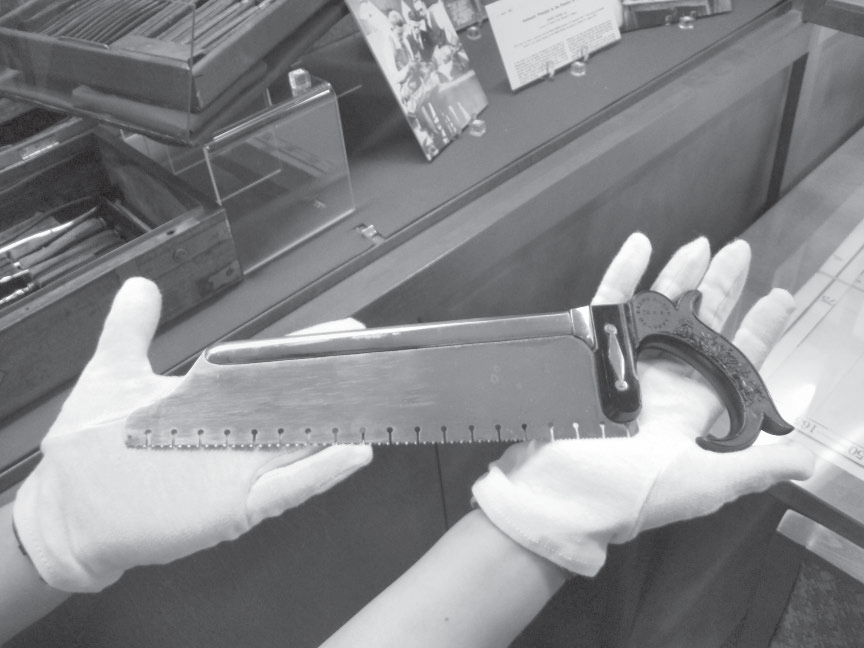Civil War Era Studies student takes a journey into medicine of the past

This saw was used for amputations and is part of a surgical set that was made in London in the 1850s for use during the Crimean War. It is one of Sherif’s favorites because of the ornate ebony handle. This handle, however, was sensitive to heat so the instrument was rinsed in tepid water, not boiled, between uses (On loan from Prof. Ian Isherwood). Photo Credit: Musselman Library
By Natalie Sherif, Contributing Writer
“I believe that everyone needs a gateway into history,” says Musselman Library’s Fortenbaugh Intern Natalie Sherif, a senior. Sherif, who is also a Civil War Institute Fellow, describes her experience as curator of the Special Collections exhibit Slow to Heal: The Evolution of Medicine from the Civil War Era to WWI. The exhibit examines medicine’s evolution from the 1830s to 1918.
What first attracted me to the past was a tour I took in fifth grade of the area where George Washington crossed the Delaware River. Our guide told us the origin of “sleep tight, don’t let the bed bugs bite,” and I was captivated from then on with history’s enduring relevance to our lives today.
For the past three years, I have been working on projects meant to engage students from outside the History and Civil War Era Studies departments in the Civil War and Gettysburg’s sesquicentennial. It was from this angle that I decided to curate an exhibit on medical evolution during the Civil War Era with the hopes to attract visitors who would otherwise not be interested in a historical exhibit.
The curating process was exhilarating. Though I have a passion for history, I strongly prefer to be in the field—engaging with the historical landscape as well as with objects and artifacts from the past. At the beginning of the curatorial process, Special Collections Director, Carolyn Sautter asked if I wanted “Slow to Heal” to use text or objects. Without skipping a beat, I said I wanted to display medical evolution through material culture.
One of the most intriguing aspects of creating the exhibit was finding connectivity to the 21st century in ways I was not expecting. For example, one of my favorite objects in the cases is a small wooden stethoscope on loan from the National Museum of Civil War Medicine in Frederick, MD.
I am still unsure why I am so drawn to such an unassuming piece of the past. Don’t get me wrong, I love the medical cases, the French amputation knives, and the stretcher, but there is something so universal about that stethoscope that brought me back to my childhood when I used to play with a powder-blue stethoscope that my mom brought home for me. When I see the instrument from the 19th century, I am struck with how similar our lives are with people who lived in the past. L.P. Hartley said, “The past is a foreign country; they do things differently there.” But I’m not so sure.
This exhibit has made me think more critically about how I conceptualize the past and its connectivity to the present. William Faulkner said, “The past is never dead; it’s not even past,” and maybe he is right. These are the types of questions that I want visitors to ask as they go through this exhibit. I want them to see the beauty and importance of these objects and realize that history is important, that it’s not dead. Because we are the future’s past and men during the Civil War used to be the present. As I handled the letters and books and medicine bottles I thought what if this is somebody’s gateway?
“Slow to Heal: The Evolution of Medicine from the Civil War Era to WWI” will be on display thru August 1, 2014 on the fourth floor of the Musselman Library in the Special Collections Reading Room. Hours are Monday-Friday 1-5 p.m. plus Tuesday-Wednesday 6-9 p.m. For more information call (717) 337-7002.
